
Great IEP writers are not born, they are made through practice, persistence, and patience. They take the time to hone their craft and have a strong drive to master writing IEPs. It is not easy and it is not a quick process, but they do the five things below consistently to make sure they are drafting the best IEP for each child. If you are struggling with IEP writing or simply looking for ways to improve your skills, take a look at the ideas below and see how you might incorporate them into your own process.
Things Great IEP Writers Do
 1 – Get to Know the Child
1 – Get to Know the Child
Great IEP writers understand that an excellent IEP cannot be done on a child they do not know. Without getting to know the student, an IEP is based on data and scores. While those things are important, it is also imperative to understand the person behind those data points. Get to know the student by talking with them. Have a conversation. Discuss likes, dislikes, home life, and their feelings about school. When the student is truly “seen” the IEP helps to reflect who they are and where they need to go throughout the school year. It also becomes much easier to write about helping a child versus helping an unknown person behind some test scores.
Get to know your students better by giving them this Student Questionnaire – you can get access to this resource wen you join The Intentional IEP! Join here, or click the image above!
2 – Include Qualitative Data
All IEPs need quantitative data to get an accurate look at how a student performs in the classroom and on tests. However, all IEPs also need qualitative data. That is the data about how hard the student tries in class, how he approaches assignments, and the things he does to help cope.
- Does he consistently give up when he gets an assignment that’s challenging or does he approach it with a can-do attitude?
- Does he build himself a file folder enclosure on his desk to help block out distractions?
- Does he get frustrated easily or is he persistent?
- Is there a fixed mindset or a growth mindset being displayed?
All of those qualitative touchpoints should be included in an IEP as they help give an overall picture of a student’s mindset and abilities. Without qualitative data, an IEP is simply just numbers and goals.
3 – Ask What the Child Needs
In the rush to complete batches of IEPs, it is easy to forget that one of the most important aspects of writing an IEP is to address the student’s actual needs. Great IEP writers start by asking, “What does this student actually need?” If there’s no understanding of the needs, the goals that are written will not address the child’s needs not will they help move him forward and keep him progressing. A student’s needs have to be the driving force behind what goals are assigned and great IEP writers know that.
4 – Create SMART Goals
SMART goals are goals that are:
- Specific
- Measurable
- Achievable
- Relevant
- Time-Bound
All IEPs should include goals that specifically meet the needs of the student. They should be measurable and easy to assess. The goals should be achievable for a student, not so far-fetched or aggressive that it sets the child up for failure. Relevant goals focus on what the child needs right now – not in the next grade or five years down the line. And each goal should have a specific time-frame for completion so that the student can work toward accomplishing it by a deadline.
Did you know?! The Intentional IEP membership it comes with over 12,000+ SMART IEP goals, so there’s never a doubt that the goals you include are going to be effective and appropriate for your students. Take it for a test spin with our trial member here.
Check out this snippet from a training inside the TII membership on writing IEP goals:
The membership also provides guidance on Having an Organized IEP Process, which can be challenging for anyone!
By joining the membership, individuals also gain access to an extensive library of over 13,000 pre-written IEP goals, empowering them with a wealth of options to support their students’ unique needs.
Learn more and become a member of The Intentional IEP today!
5 – Use Templates
Great IEP writers know that focusing on the content of the document is the most important part of an IEP. That’s why they use templates. Not only do templates save time, but they’re an easy way to make sure that everything that needs to be included in the IEP is included.
- The IEP Toolkit is a great resource for teachers and service providers who write IEPs, as it includes the templates needed, like the Present Levels template, as well as 340 accommodations and modifications and lots of other moving parts. The IEP Toolkit really takes the guesswork out of what to put in each IEP. See all of what’s included in the IEP Toolkit here.
Creating the perfect IEP is not easy, but great IEP writers know that when they get to know their students, include qualitative data, have a firm understanding of what each child needs, and put goals in a SMART format, their students’ needs will be met through the IEP document. Each child is worth the time it takes to craft an exceptional IEP based on what they need and can achieve.







